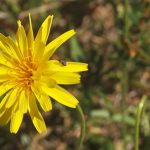
 Important note about plant availability. Important note about plant availability.There are hundreds of factsheets on our website provided for your information. Not all plants will be available at all times throughout the year. To confirm availability please call (03) 8850 3030 and ask for the nursery. |
Dwarf Pigface
Mesembryanthemum crystallinum (Pigface) and Mesembryanthemum nodiflorum
Flowers are prolific in late spring to early summer, in vivid colours from white, pale pink to deep pink, lemon yellow to deep yellow, soft apricot to bright orange, mauve to purple and deep reds. They open in the morning and close again each night.
Requires a sunny position to flower well, and will form a dense low growing mat.
Does well in low fertility, poorly drained soils. Accumulates salts. These leach back into the soil after the plant dies, making it difficult for other less salt tolerant species to establish.
Has the physiological advantage of being able to switch between C3 photosynthesis when water is in plentiful supply and CAM (Crassulacean Acid Metabolism) photosynthesis in drought or highly saline conditions. This enables them to survive and thrive in very difficult conditions.
Leaves and seeds are edible. Crushed leaves can be used as a soap substitute.
Livingstone Daisy
Mesembryanthemum criniflorum (Initially reclassified as Dorotheanthus bellidiformis and then reclassified as Cleretum bellidiforme)
Annual or semi-annual succulent prostrate plant with spectacular iridescent daisy type flowers in an amazing array of colours. Flowers will only open in the sun, so plant in a very sunny position. Foliage is often a bit shabby looking, but almost irrelevant once it flowers. Protect from slugs and snails.
Will do well in poor fertility and dry sites. Freely self-seeds, so will re-appear each year. Prefers cool wet winters and hot dry summers, well suited to the Melbourne climate. Is not, however, frost tolerant.

Karkalla
Carpobrotus glaucescens and Carpobrotus rossii
Carpobrotus glaucescens and Carpobrotus rossii are two of our native pigfaces and are a prostrate, creeping succulent with long trailing stems and thick, fleshy, smooth leaves. They can shrivel up and look almost dead in dry times, but a small amount of water will see them come good and grow again. Wonderful pinky purple large flowers, mainly from spring to summer, but will randomly flower at other times. Both are a native food and the red/purple fruit is edible with a sweet/salty taste. Good for all coastal areas, well adapted to very sandy soils and saline conditions. Carpobrotus rossii is a well recognised native food source, with leaves and fruit being regularly used.
Oscularia deltoides
(Many synonyms, commonly called Lampranthus)
Three-sided short fat succulent silver blue foliage is attractive in its own right, but this plant is grown for its masses of pink, almond scented flowers. Easy to grow, but not frost tolerant. Prefers a sunny well drained position. Reputed to attract butterflies.
Drosanthemum speciosum
Intense and vivid orange/red flowers, opening in the morning and closing in the evening. Small succulent foliage. Sunny well drained position.


